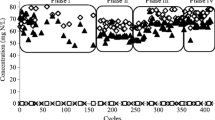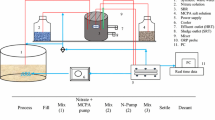Abstract
The kinetic behavior, oxidizing ability and tolerance to m-cresol of a nitrifying sludge exposed to different initial concentrations of m-cresol (0–150 mg C L−1) were evaluated in a sequencing batch reactor fed with 50 mg NH4 +-N L−1 and operated during 4 months. Complete removal of ammonium and m-cresol was achieved independently of the initial concentration of aromatic compound in all the assays. Up to 25 mg m-cresol-C L−1 (C/N ratio of 0.5), the nitrifying yield (Y-NO3 −) was 0.86 ± 0.05, indicating that the nitrate was the main product of the process; no biomass growth was detected. From 50 to 150 mg m-cresol-C L−1 (1.0 ≤ C/N ≤ 3.0), simultaneous microbial growth and partial ammonium-to-nitrate conversion were obtained, reaching a maximum microbial total protein concentration of 0.763 g L−1 (247 % of its initial value) and the lowest Y-NO3 − 0.53 ± 0.01 at 150 mg m-cresol-C L−1. m-Cresol induced a significant decrease in the values of both specific rates of ammonium and nitrite oxidation, being the ammonium oxidation pathway the mainly inhibited. The nitrifying sludge was able to completely oxidize up to 150 mg m-cresol-C L−1 by SBR cycle, reaching a maximum specific removal rate of 6.45 g m-cresol g−1 microbial protein-N h−1. The number of SBR cycles allowed a metabolic adaptation of the nitrifying consortium since nitrification inhibition decreased and faster oxidation of m-cresol took place throughout the cycles.




Similar content being viewed by others
References
Amor L, Eiroa M, Kennes C, Veiga MC (2005) Phenol biodegradation and its effect on the nitrification process. Water Res 39:2915–2920
APHA (1998) Standard methods for the examination of water and wastewater, 20th edn. American Public Health Association, Washington
Butturini A, Battin TJ, Sabater F (2000) Nitrification in stream sediment biofilms: the role of ammonium concentration and DOC quality. Water Res 34:629–639
Data T, Liu Y, Goel R (2009) Evaluation of simultaneous nutrient removal and sludge reduction using laboratory scale sequencing batch reactors. Chemosphere 76:697–705
Delgado A, Aspé E, Martí MC, Roeckel M (2004) The effect of volatile fatty acids on the nitrification of a saline effluent. Environ Technol 25:413–422
Dyreborg S, Arvin E (1995) Inhibition of nitrification by creosote contaminated water. Water Res 29:1603–1606
Hanaki K, Wantawin C, Ohgaki S (1990) Effects of the activity of heterotrophs on nitrification in a suspended growth reactor. Water Res 24:289–296
Hyman MR, Sansome-Smith AW, Shears JH, Wood PM (1985) A kinetic study of benzene oxidation to phenol by whole cells of Nitrosomonas europaea and evidence for the further oxidation of phenol to hydroquinone. Arch Microbiol 143:302–306
Keener WK, Arp DJ (1993) Kinetic studies of ammonia monooxygenase inhibition in Nitrosomonas europaea by hydrocarbons and halogenated hydrocarbons in an optimized whole-cell assay. Appl Environ Microbiol 59:2501–2510
Keener WK, Arp DJ (1994) Transformations of aromatic compounds by Nitrosomonas europaea. Appl Environ Microbiol 60:1914–1920
Kim KT, Kim IS, Hwang SH, Kim SD (2006) Estimating the combined effects of copper and phenol to nitrifying bacteria in wastewater treatment plants. Water Res 40:561–568
Kim YM, Park D, Lee DS, Park JM (2008) Inhibitory effects of toxic compounds on nitrification process for cokes wastewater treatment. J Hazard Mater 152:915–921
Lowry OH, Rosenbrough NJ, Farr AL, Randall RJ (1951) Protein measurement with the Folin phenol reagent. J Biol Chem 193:265–275
McCarty GW (1999) Review article: modes of action of nitrification inhibitors. Biol Fertil Soils 29:1–9
Moreno JA, Bentancur MJ, Buitrón G, Moreno-Andrade I (2006) Event-driven time-optimal control for a class of discontinuous bioreactors. Biotechnol Bioeng 94:803–814
Olmos A, Olguin P, Fajardo C, Razo E, Monroy O (2004) Physicochemical characterization of spent caustic from the OXIMER process and sour waters from Mexican oil refineries. Energy Fuels 18:303–304
Saravanan P, Pakshirajan K, Saha P (2009) Batch growth kinetics of an indigenous mixed microbial culture utilizing m-cresol as the sole carbon source. J Hazard Mater 162:476–481
Silva CD, Gomez J, Houbron E, Cuervo-López FM, Texier AC (2009) p-Cresol biotransformation by a nitrifying consortium. Chemosphere 75:1387–1391
Stafford DA (1974) The effect of phenols and heterocyclic bases on nitrification in activated sludge. J Appl Bacteriol 37:75–82
Strauss EA, Mitchell NL, Lamberti GA (2002) Factors regulating nitrification in aquatic sediments: effects of organic carbon, nitrogen availability, and pH. Can J Fish Aquat Sci 59:554–563
Suárez-Ojeda ME, Guisasola A, Baeza JA, Fabregat A, Stüber F, Fortuny A, Font J, Carrera J (2007) Integrated catalytic wet air oxidation and aerobic biological treatment in a municipal WWTP of a high-strength o-cresol wastewater. Chemosphere 66:2096–2105
Texier AC, Gomez J (2004) Settleability and kinetics of a nitrifying sludge in a sequencing batch reactor. Can J Microbiol 50:943–949
Texier AC, Gomez J (2007) Simultaneous nitrification and p-cresol oxidation in a nitrifying sequencing batch reactor. Water Res 41:315–322
van Niel EWJ, Robertson LA, Kuenen JG (1993) A mathematical description of the behaviour of mixed chemostat cultures of an autotrophic nitrifier and a heterotrophic nitrifier/aerobic denitrifier; a comparison with experimental data. FEMS Microbiol Ecol 102:99–108
Veeresh GS, Kumar P, Mehrotra I (2005) Treatment of phenol and cresol upflow anaerobic sludge blanket (UASB) process: a review. Water Res 39:154–170
Verhagen FJM, Duys H, Laanbrock HJ (1992) Competition for ammonium between nitrifying and heterotrophic bacteria in continuously percolated soil columns. Appl Environ Microb 58:3303–3311
Zepeda A, Texier AC, Gomez J (2003) Benzene transformation in nitrifying batch cultures. Biotechnol Prog 19:789–793
Zepeda A, Texier AC, Razo-Flores E, Gomez J (2006) Kinetic and metabolic study of benzene, toluene, and m-xylene in nitrifying batch cultures. Water Res 40:1643–1649
Acknowledgments
This work was supported by CONACYT (169563) and PROMEP (103.5/07/2554; 103.5/10/5329).
Author information
Authors and Affiliations
Corresponding author
Rights and permissions
About this article
Cite this article
Zepeda, A., Ben-Youssef, C., Rincón, S. et al. Complete and simultaneous removal of ammonium and m-cresol in a nitrifying sequencing batch reactor. Biodegradation 24, 377–385 (2013). https://doi.org/10.1007/s10532-012-9595-0
Received:
Accepted:
Published:
Issue Date:
DOI: https://doi.org/10.1007/s10532-012-9595-0




